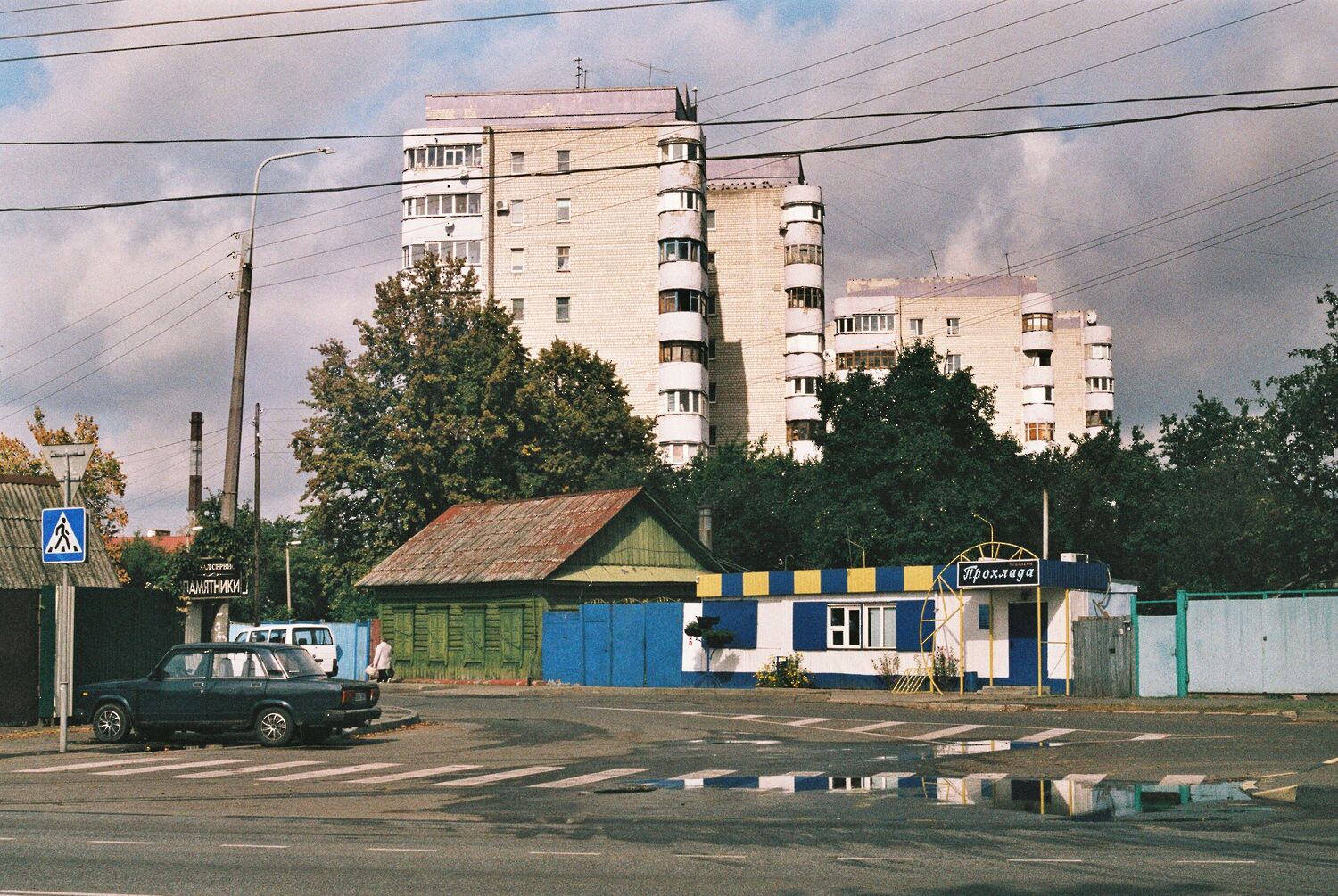I. Ideology, pragmatism and the Republic of Belarus
‘Belarus, by history, fate and location, was evidently chosen to fulfil a great role as the spiritual leader of the east Slavic civilisation… realising this destiny can propel our nation to great feats.’
President Alexander Lukashenko, 2006
It seems inconceivable that something equivalent could have been said, at least in the twenty-first century, by the leader of any other European country. With all its teleological grandiloquence, this is precisely the kind of ‘grand narrative’ towards which, according to postmodern theory, we should now be incredulous. But it is perhaps not surprising that the Republic of Belarus should have resisted the ‘postmodern awareness’ that sees contingency, rather than fate, as destiny. It has not undergone the same processes of post-industrialisation as much of the Western world, nor embraced consumerism and free-market capitalism to any comparable extent. Although Marxism-Leninism is no longer the official state ideology, the government under Alexander Lukashenko has preserved many of its socio-economic fundamentals. Buffeted by invasion throughout its history, and shaken by several abortive attempts to establish an independent state, Belarus is to some extent a prisoner of its geography – a liminal zone; a periphery on two fronts. I wanted to visit the country to get a fuller sense of how these tensions play out in everyday life. And after spending ten days in Minsk and Gomel, it seems possible to me that Belarus may stay the path politically for a while to come; and that if there is a threat to the status quo, it may be more likely to come from Russia than from the West.
At the time of Lukashenko’s election in 1994, many in his circle were positing the ‘non-objective’ end of the Soviet Union as just the next phase in the East-West ‘megacycle’ of world history. On the other side of the former iron curtain, meanwhile, prevailing intellectual currents posited a ‘post-ideological’ age in which the prescriptions of neoclassical economics had finally overcome the tyranny of conceptual systems based on faith and dogma. Today, as populist movements on both the left and the right challenge established norms and values, destabilising old solids, the sense of optimism pervasive in ‘EU 2010’ – a report published by the Centre for European Reform envisioning Belarusian accession within a decade – seems long evaporated. And as the Russian Federation seeks to re-establish itself as a global power, the hubris is becoming increasingly plain: the world has not transcended ‘ideology’, however the equivocal concept is to be understood.
Alongside Donald Trump, Recep Tayyip Erdoğan, Viktor Orbán and Rodrigo Duterte, Alexander Lukashenko begins to seem almost benign.
If conceived narrowly as a body of action-oriented beliefs about how society should be organised, it is certainly plausible that Lukashenko’s remarks on the destiny of Slavic civilisation reflected longstanding convictions. The ideas of Soviet restorationism that characterised his early rule were still relevant in 2006, but a new discourse had begun to emerge in which Russia was increasingly condemned for having fallen into a state of decadent oligarchy. But ‘ideology’ also encompasses the ways in which political processes are expressed in the realm of signification, or, alternatively, the way meaning is deployed in the service of dominant groups. Seen from this perspective, the shift in rhetoric may have been informed by the need to justify changed economic and geopolitical circumstances to the people – by pragmatic self-interest alone. The standard narrative in the West is that Belarusians live in a ‘facade democracy’ – an essentially ‘alegal’ environment in which the political system is not protected by its own constitution. Sanctions are justified on the grounds that the president is a dictator, the media is controlled and the people are brainwashed – living, in other words, in a state of false consciousness. But this suggests that there is some unequivocally correct way of organising society. The difficulties, then, are clear: both conceptually and materially, ideology slips and slides.
II: Minsk: Coca-Cola, Huawei and the Stolitsa Shopping Centre
The Minsk metro system, like others in the former Soviet Union, is thoughtfully and sometimes lavishly decorated. On the platform at Plošča Jakuba Kolas, pillars are embellished with clay reliefs depicting scenes from Slavic folk culture. They support the four lanes of Independence Avenue, a rumbling arterial boulevard connecting the city centre to the north-east. But this ‘magistrale’ – and others like it in East Berlin, Kiev and Warsaw – represented much more than a thoroughfare: it was the main route for theatrical military parades during the Stalin era. The square above is busy; commuters throng in and out of underpasses as vehicles barrel into the city. There is a huge, roughly rendered sculpture of the Belarusian poet Jakub Kołas, whose work paid homage to the kind of traditional life celebrated by the station’s decor, which goes largely ignored. Across the road, I am momentarily struck by two lofty Coca-Cola signs (which the company calls ‘spectaculars’) mounted to the roof of an apartment block. It is a jarring sight, but to the commuters around me, a very normal one: Coca-Cola has been operating in Belarus since 1994 via a subsidiary which describes itself, somewhat brazenly, as ‘a local company with international roots’. To me, like most people, the iconic cursive speaks only of the Atlanta Coca-Cola Company, which now operates in every country except Cuba and North Korea. The brand it controls has so thoroughly appropriated this space that locals refer to it as ‘Coca-Cola Square’ – a dramatic turnaround for a drink once seen as emblematic of American imperialism. The two signs are one of the boldest expressions of third-wave globalisation in the city, and yet, supported by a very obvious scaffold, there is something comparatively quaint about them: last year in Times Square, the Coca-Cola Company installed the world’s first robotic billboard, incorporating hundreds of independently moving LEDs to generate an almost hypnotic undulating pattern.
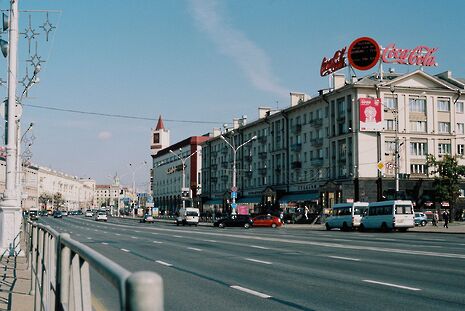
The intrigue of Coca-Cola Square is amplified by the building opposite, which carries another large logo: in the equivalent position, the red petals of Chinese telecommunications giant Huawei flash seductively above the traffic. This is a symbolic standoff between two great economic powers: one ascendant, one perhaps in terminal decline; but both vying for influence in this emerging market. Fives stops along the metro line is Independence Square – a vast, austere expanse of concrete where parades once culminated in mass rallies. On the north side is the House of Government, one of the few major examples of constructivism left in Minsk, and formerly the meeting place of the Supreme Soviet of the BSSR. It is a totalitarian structure: vertiginous, symmetrical, bereft of subtlety. The effect is intensified by a huge statue of Lenin – after whom the square used to be named – grasping what looks like a guillotine. At its base, finely crafted friezes show Bolshevik revolutionaries rising up against the Provisional Government. Perhaps the most striking feature of the square, however, are the three glass domes which protrude from the otherwise spartan paving. Encircled by fountains and topped with ornate avian sculptures, they open on to the glitzy Stolitsa Shopping Centre, which the official state website promotes as one of Minsk’s ‘most popular attractions’. Beneath the solemn austerity of Independence Square, shoppers drift up and down gleaming walkways lit by chandeliers.
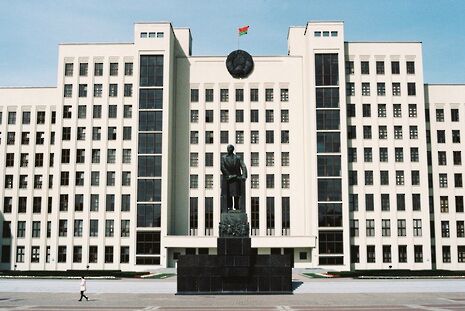
Not far away, the city offers up a true astonishment. On the corner of a busy street, I find a KFC dwarfed by a monumental triumphalist relief. Under the weight of this concrete-berg and the abstractions it embodies – glory, eternity and solidarity – it is as though the fast-food outlet should buckle. But, of course, it is the KFC supporting the monument.
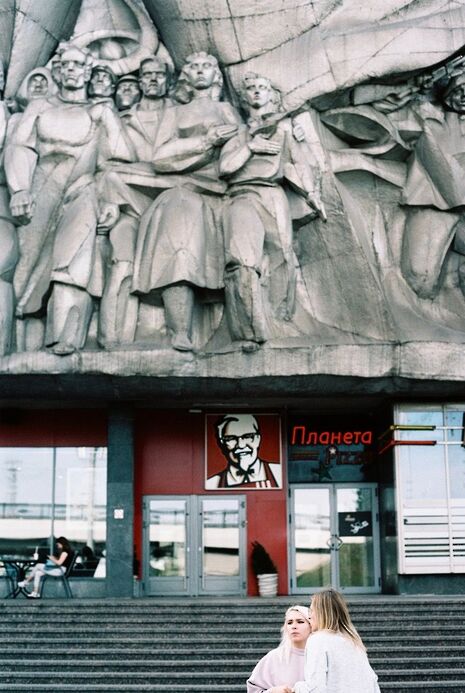
III. Post-structuralism, structural change and the deceptions of urban spaces
Post-structuralist thought emphasises the instability of meaning: in the realm of the mind, signs and symbols are subject to infinite interpretation by different agents. There is no fixed relationship between signifier and signified, only indeterminate language games. But there is also, I think, a mode of perceiving and interpreting that is quite particular to each society. The interplay between communism and capitalism on the terrain of signification is notable to me, a visitor from London, but without any competence in Russian, I cannot gain any meaningful access to the Belarusian social conscience. It is clear that locals still attach some significance to their Soviet heritage: on exiting the metro station at Plošča Lienina, some people rub a bronze Lenin’s nose for luck, but whether this is out of habit, convention or conviction, I can only speculate.
However, in the material realm, it is safe to say that these juxtapositions are indicative of the interlinked structural, geopolitical and ideological developments that have fuelled third-wave globalisation and the time-space dilation it entails. The presence of Coca-Cola and KFC in Belarus attests to a new pragmatic openness to foreign capital, and a moderation in anti-American rhetoric. The more recent arrival of Huawei speaks to the fact that the government has been cautiously pivoting towards China since the financial crisis. When Lukashenko first came to power, the West was portrayed as the natural enemy of Slavic civilisation. Steps were taken towards renewed integration with Russia, but the project has stalled due to growing animosity between the two governments. The economic model that sustained growth in Belarus until 2006 was predicated on massively subsidised oil and gas imports from Russia, which made its high-value export goods – notably tractors, trucks and fertilisers – competitive in both European and CIS markets. But in 2006, Russia began to raise prices as part of an effort to make the increasingly disobliging Belarusians more pliable to currency union, among other things. So Lukashenko turned to the wider world, announcing a new, ‘many-winged’ foreign policy predicated on greater cooperation with non-aligned countries. When Belarusian industry was hit by a collapse in Russian demand during the financial crisis, Beijing came to its aid. And the government has recently committed to become a key ‘pearl’ for China’s trillion-dollar Belt and Road Initiative.
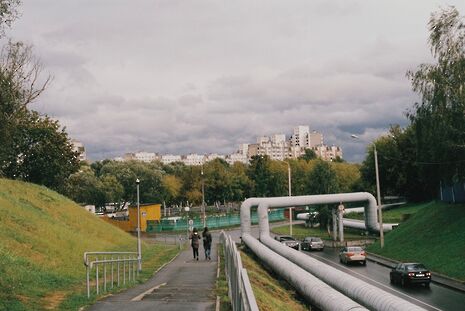
Officials in Beijing describe it as a cooperative enterprise (‘a chorus of all participating countries’) to spread prosperity, but Western analysts generally consider it part of a solo attempt by China to consolidate hegemony in the Eastern hemisphere. New ports, high-speed railways, power plants and factories are to be constructed across Eurasia and Africa, drawing ever more countries into China’s sphere of action. The most significant manifestation of Chinese influence in Belarus thus far is the ‘Great Stone’, a Special Economic Zone on formerly arable land close to Minsk International Airport, which is becoming an important transcontinental hub. The site specialises in what Lukashenko calls ‘the production of tomorrow’ – research and development in software, electronics, biomedicine and material science. At the gates, a sign reads ‘time is money, efficiency is life’. This is clearly the beginning of an important new era in Belarusian foreign policy, but there has been little attempt to justify it ideologically. Although the Moscow International Business Center is hardly more decadent than Macau, the gambling capital of the world, the government simply says the Great Stone is good for jobs. Similarly, in preserving the iconography of the Soviet Union across the country, it seems as though the state is very deliberately pretending that nothing has changed. It is tempting to think of the Stolitsa Shopping Centre and the hollowed-out Independence Square as a metaphor for the country as a whole. The irony of the juxtaposition is certainly very great. When Lenin diagnosed capitalism as ‘moribund’ in 1916, it could not have occurred to him that, a century later, frivolous consumption in a disenchanted post-Soviet world might amount to what Zygmunt Bauman calls an ‘instrument of pattern-maintenance’.
Minsk is certainly not all that it seems: its outward forms and idioms are curiosities of a lost past. But while it may appear that Belarus has adopted something akin to the Western mode of consumption, the deception works on two levels: as has been stated, the country remains an anomaly. Perhaps even the dissonance at KFC isn’t as acute as it first appears: methodologically, if not ideologically, these two apparently contradictory sign-systems may in fact represent the same ambition. During the late 1950s, there was high optimism about science in the USSR, when rapid industrialisation and successes in space exploration dramatised the possibilities of technological progress. The same positivistic spirit aimed to maximise efficiency in the economic sphere, by substituting market prices with ‘material balance’ – the harmonisation of inputs and outputs. There are distinct parallels between this and the four dimensions of instrumental reason that, according to George Ritzer’s ‘McDonaldization theory’, spread from fast-food restaurants to society at large: efficiency, calculability, predictability, and control. The means, if not the ends, are notably similar.
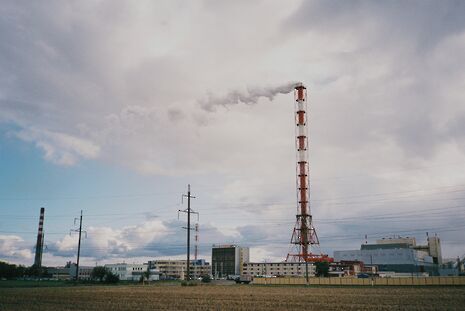
In other former Soviet or Soviet-satellite countries, formal decommunisation drives have purged symbolism from the built environment. For example, Ukrainian legislation passed in 2015 led to the removal or destruction of 1,320 Lenin monuments. In the former German Democratic Republic, by contrast, entrepreneurs have capitalised on a sense of ostalgie for life in East Germany. But in Belarus, the symbolism is so deeply enmeshed in the urban fabric that it seems unremarkable and uncontroversial. It offers, perhaps, a sense of continuity to a lost but cherished past, fodder for a fragile national identity.
IV. The Great Patriotic War, architectural triumphalism and infrastructural transparency
Many of the essential characteristics of modern Belarus, including its borders, demographics, built environment and, I suspect, its continued adherence to aspects of the Soviet socio-economic model, are an inheritance of World War II. More than anywhere else in Europe, the ideologies of fascism and communism, embodied in incommensurable discourses about purity, freedom and destiny, collided in this territory. Hitler launched a three-pronged invasion of the USSR in June 1941, famously reneging on the Molotov-Ribbentrop Pact of 1939. He was expecting to have captured Leningrad, Moscow and Kiev within three months. In the years that followed, the territory of Belorussia was scene to some of the most brutal, bloody and – in the West – least-known conflicts of the war. The provisions of Generalplan Ost, the Nazis’ plan for the enslavement, expulsion and extermination of most Slavic peoples, were never fully implemented, but their scorched earth strategy led to untold destruction. By the war’s end, approximately half the Belarusian population had been either killed or displaced – a proportional cost much higher than in any other European country. This unique magnitude is surely an important factor in explaining the distinct path taken by Belarus since it was forced to redefine itself as an independent nation-state.
The mythical power of the resistance movement is deeply implanted in the national psyche, and also strongly embodied in the architecture of Minsk, which is so infused with ideology from the ground up that it would be almost futile to remove the more superficial signs and symbols of communism. It is an eclectic place; a mix of neoclassical, baroque, modernist and constructivist architecture – and, to some, an ‘Enlightenment city’ of landscaped gardens, spires, axial streets and colonnades as much as it is a Soviet one of imposing magistrales and sprawling housing estates. The city’s most important commemorative monument is to be found at Victory Square, where, at the foot of an obelisk, youths in military uniform stand watch over the Eternal Flame. The essential message is clear: millions of victims died for a cause of transcendent value, which, if they are to be honoured, must not only be recognised by the state, but also preserved – materially, institutionally and ideologically. And this, of course, can only be achieved in a correspondingly repressive political environment. Not far away, the heavily engineered River Svislach flows alongside an embankment path delineated by repeating units of a strange concrete shape. It calls to mind a swastika – but one clinically sliced, and contorted into something resembling a fossilised scorpion pincer. As standalone sculptures, they would be useless for any practical purpose; but together, they form an integral, functional whole. The parallel is clear. But there is also a certain tension encoded in the shapes: their almost-rectangles evoke a kind of magnetic repulsion – a bipolar world, two ideological systems in necessarily irreconcilable conflict. They seem to say, quietly, that out of one victory springs another struggle.
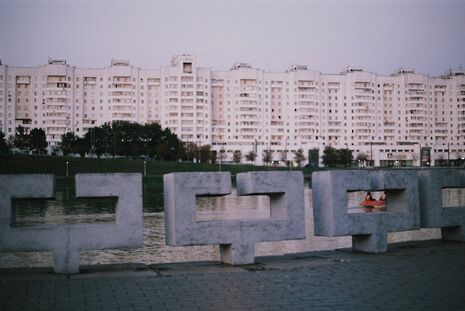
The subtlety does not extend to the opposite bank, where an extraordinary extravagance stretches into the distance. It is like a Stalinist incarnation of the Disneyland castle, crossed with a space-ark; there are little domed bartizans, a triangular tympanum and a stout spire, but also sheer facades, a modular structure and lots of glass. The effect is overbearing, but not exactly totalitarian – the building would not appear out of place on the Las Vegas strip. And there is a peculiar sense of impermanence about the edifice: its tiered sections look as though they might be dismantled with relative ease. I assumed for a while that this kind of residential monumentalism had been abandoned after Stalin’s death. But from the roof of the National Library – one of Lukashenko’s more kitsch additions to the urban fabric – I could make out a similarly bombastic apartment building in the final stages of construction. It mimics the dominant symmetry of the House of Government, while maintaining the great scale of the building next to the Svislach. As part of a grand and apparently continuing attempt to aggrandise the ordinary citizen, these are indeed palaces of the people. However, I suspect that in fostering any sense of real community, their generative power is rather wanting.

V. The future: Belarus in a new age of ideology
Since the collapse of the Soviet Union, ideology in Belarus has both atrophied into a kind of performative relic, and operated as a dynamic and generative social and political force. It has provided stability, continuity, and a source of national identity, while the ever-opportunistic president has found ways to facilitate new forms of consumption and entertainment by exploiting neoliberal globalisation. For as long as cheap Russian oil and a stable export market kept the people in work and foreign demand high, the provisions of the state’s expansive social contract could be met. The regime could sustain high living standards, economic growth and, by extension, itself, without much cultural or financial exposure to hostile ideologies. But since having to adapt to Russian pressure and the global financial crisis, the government has been forced to loosen its grip, leading to increased permeability to foreign capital, goods and people. If, in a truly ‘post-ideological world’, the neoliberal tide could keep washing in forever, it seems likely that Lukashenko and his allies would succumb either to economic pressure from the West or to a popular uprising provoked by increased exposure to alternative norms and values. But, due to the impact of two (interlinked) intervening factors, the prospect of imminent regime change in Minsk seems to me quite remote.
First, Lukashenko has managed to secure domestic stability for the short to medium-term thanks in part to his growing entanglement with an economically expansionist China. And if, as the Belarusian government apparently believes, the international system is about to be remade in China’s image, the scope for meaningful political pressure from the West will at some point be radically diminished. The Chinese state is currently developing sinister new forms of social control that exploit the power of big data, artificial intelligence and biometric sampling to aggregate information about its citizens and identify anomalies in databases. There is no reason to believe that this kind of technology would not be transmitted to receptive states if the liberal-democratic order slips. However, if it does appear to a resurgent Russia that China is gaining too much influence in Eastern Europe, it is not unthinkable that Putin or his successor will decide to launch a ‘defensive’ occupation of Belarus – justified, perhaps, along similar lines to the annexation of Crimea in 2014. Such an invasion would be predicated on the second intervening factor: democratic decay on a global scale and the rise of populism in the West. As ideas of multilateralism, multiculturalism and globalisation go into retreat, nationalism, exceptionalism and protectionism move in to fill the void.
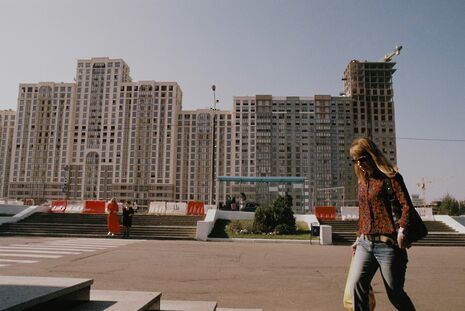
In this emerging order of demagogues, the European Union is faced with intractable internal problems of its own, which necessarily consume its resources and damage its international credibility. The bloc has recently eased sanctions on Belarus, and Minsk is to host the European Games next year despite human rights concerns. Alongside Donald Trump, Recep Tayyip Erdoğan, Viktor Orbán and Rodrigo Duterte (all democratically elected), Alexander Lukashenko begins to seem almost benign. Some have speculated that, as the last of the partisans die off and the younger generation moves into positions of influence, Belarus could be in store for a popular revolution. In a well-educated and highly urbanised country, the risks do appear high. But the paradox is that the emergence of the kind of discourses that might provoke widespread revolutionary fervour to begin with is conditional, at least in times of peace and prosperity, on a reconfiguration of society’s relationship to authority. A Belarusian ‘politics of the self’ could only come about through post-structuralist liquidation of traditional sources of solidity. It is beyond my scope here to decide whether or not Lukashenko can really be considered ‘Europe’s last dictator’. But I will suggest that he may have managed, whether out of ideological conviction or pragmatic self-interest, to steer the country through the zenith of liberal democracy into a darker, more unpredictable age where authoritarian government is the norm, not the exception.

